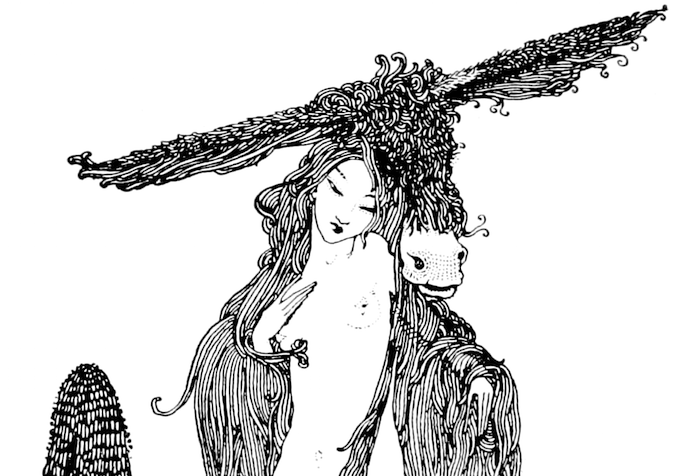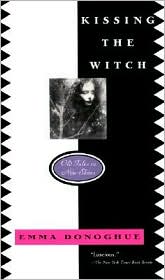Throwback Thursday: Rediscovering Emma Donoghue’s Kissing the Witch
 Chris Riddell is the U.K.’s new Children’s Laureate, and the internet is full of The Sleeper and the Spindle illustrations once more. You know the picture I’m talking about, though the Neil Gaiman collaboration won’t be published in the U.S. until the fall (you can pre-order it here); a woman with snow-white skin and hair the color of ebony wood leans in to kiss a ghostly sleeping beauty. The image went viral when the book came out in the U.K. last year, and why not? It’s stunning.
Chris Riddell is the U.K.’s new Children’s Laureate, and the internet is full of The Sleeper and the Spindle illustrations once more. You know the picture I’m talking about, though the Neil Gaiman collaboration won’t be published in the U.S. until the fall (you can pre-order it here); a woman with snow-white skin and hair the color of ebony wood leans in to kiss a ghostly sleeping beauty. The image went viral when the book came out in the U.K. last year, and why not? It’s stunning.
It’s also misleading. Despite headlines to the contrary, The Sleeper and the Spindle is no lesbian retelling of Snow White and Sleeping Beauty, but something much darker, more complicated, and original. A kiss can mean a lot of things, and this particular kiss doesn’t exactly imply true love. It’s a good story, but readers drawn in by promises of Lesbian! Snow! White! !!!—a promise never made by the book’s creative team—may be disappointed by Fairytale Katy Perry’s Adventures Amongst the Zombies. The Sleeper and the Spindle is gorgeous, but it’s not what readers are expecting.
Kissing the Witch: Old Tales in New Skins
Kissing the Witch: Old Tales in New Skins
In Stock Online
Paperback $11.99
Kissing the Witch isn’t what readers expect either, and yet I can’t hear “The Sleeper and the Spindle” without trying to push it on someone. Emma Donoghue’s collection of linked fairytales about women was published in 1997, long enough ago that books marketed to a general YA audience didn’t use words like lesbian on the cover; it instead promises “Old Tales in New Skins.” I took it off the shelf (this was suburban Massachusetts; it actually was at a Barnes & Noble), bought it, and brought it home, past the eyes of my watchful mother, without suspecting there was anything queer about it. There’s a blurb from The San Francisco Examiner promising that the stories inside are “revolutionary,” but it doesn’t say why.
Here’s your lesbian Cinderella story, your tale of what the mysterious Beast’s disguise is truly hiding. Rumplestiltskin becomes “The Tale of the Spinster,” a story about a hard-nosed workaholic who doesn’t pay attention to the strange woman who comes to live with her until it’s too late. The final story, “The Tale of the Kiss,” which gives the book its title, takes the sea witch from The Little Mermaid as its main character. “On the whole, I am inclined to think that a witch should not kiss,” she muses.
Perhaps it is the not being kissed that makes her a witch; perhaps the source of her power is the breath of loneliness around her. She who takes a kiss can also die of it, can wake into something unimaginable, having turned herself into some new species.
No, this is not a romance.
Kissing the Witch queers fairytales, but not in the lazy, shallow, “replace Prince X with Princess Y” sense. It goes deep to the emotional core of a story—a dress the color of stars is all very well, but can you marry a man who only loves you in disguise?—to create fables in which the emotions and experiences of the characters are impossibly real. If these are fractured fairytales, the emphasis is on the tale, not the fracture; in that last example, “The Tale of the Skin,” Donkeyskin takes no satisfaction in dodging the happy ending Perrault set out for her. She thought the prince was handsome. But she’s upset that he doesn’t see her, and she’s been through a lot, and she needs to find out who she is underneath all those costumes.
It’s this process of self-discovery that recurs most often throughout the collection. With few exceptions, love stories are not the focus here: the stories feature a variety of heroines, and half the time we never know a character’s orientation, which is the most radical thing of all. If some happy endings are lost, other, sadder tales receive happier ones; the fisherman’s daughter who gives up her voice for a man goes on to marry a different man “who liked to hear me sing, but preferred to hear me talk.” Every story describes a turning point in the main character’s life when her story becomes her own.
None of this begins to describe everything that makes Kissing the Witch a must-read for anyone who loves fairytales. I haven’t mentioned Donoghue’s lush prose, which, once read, sounds like a story you’ve known all your life, lines so perfect and vivid it’s hard to believe they haven’t always existed in the ether somewhere, waiting to be heard. “Your face is no fortune, so elbow grease must be your dowry,” a character’s mother tells her. Another explains, “In the days when wishing was having, I got what I wished and then wished I hadn’t.” Stories are simple enough in their outlines that I could enjoy them even as the world’s most clueless 7th-grader; rereading them as an adult, I see the subtleties I missed in the beginning, the rough edges my own ignorance smoothed over: the loneliness of the witch, the desperation of the woman trapped in a life too small for her, who nurses a bird back to life in order to set something free. Donoghue’s stories do what fairytales ought to do, and so rarely accomplish: they compress a novel’s worth of emotions into a story that can be read in one sitting, or stretch out a poem to the length of a story. They are dark, but they are hopeful. They promise magic in a world that we recognize.
“This is the story you asked for,” says the witch. She’s not good, she’s not nice; she’s just right.
Kissing the Witch isn’t what readers expect either, and yet I can’t hear “The Sleeper and the Spindle” without trying to push it on someone. Emma Donoghue’s collection of linked fairytales about women was published in 1997, long enough ago that books marketed to a general YA audience didn’t use words like lesbian on the cover; it instead promises “Old Tales in New Skins.” I took it off the shelf (this was suburban Massachusetts; it actually was at a Barnes & Noble), bought it, and brought it home, past the eyes of my watchful mother, without suspecting there was anything queer about it. There’s a blurb from The San Francisco Examiner promising that the stories inside are “revolutionary,” but it doesn’t say why.
Here’s your lesbian Cinderella story, your tale of what the mysterious Beast’s disguise is truly hiding. Rumplestiltskin becomes “The Tale of the Spinster,” a story about a hard-nosed workaholic who doesn’t pay attention to the strange woman who comes to live with her until it’s too late. The final story, “The Tale of the Kiss,” which gives the book its title, takes the sea witch from The Little Mermaid as its main character. “On the whole, I am inclined to think that a witch should not kiss,” she muses.
Perhaps it is the not being kissed that makes her a witch; perhaps the source of her power is the breath of loneliness around her. She who takes a kiss can also die of it, can wake into something unimaginable, having turned herself into some new species.
No, this is not a romance.
Kissing the Witch queers fairytales, but not in the lazy, shallow, “replace Prince X with Princess Y” sense. It goes deep to the emotional core of a story—a dress the color of stars is all very well, but can you marry a man who only loves you in disguise?—to create fables in which the emotions and experiences of the characters are impossibly real. If these are fractured fairytales, the emphasis is on the tale, not the fracture; in that last example, “The Tale of the Skin,” Donkeyskin takes no satisfaction in dodging the happy ending Perrault set out for her. She thought the prince was handsome. But she’s upset that he doesn’t see her, and she’s been through a lot, and she needs to find out who she is underneath all those costumes.
It’s this process of self-discovery that recurs most often throughout the collection. With few exceptions, love stories are not the focus here: the stories feature a variety of heroines, and half the time we never know a character’s orientation, which is the most radical thing of all. If some happy endings are lost, other, sadder tales receive happier ones; the fisherman’s daughter who gives up her voice for a man goes on to marry a different man “who liked to hear me sing, but preferred to hear me talk.” Every story describes a turning point in the main character’s life when her story becomes her own.
None of this begins to describe everything that makes Kissing the Witch a must-read for anyone who loves fairytales. I haven’t mentioned Donoghue’s lush prose, which, once read, sounds like a story you’ve known all your life, lines so perfect and vivid it’s hard to believe they haven’t always existed in the ether somewhere, waiting to be heard. “Your face is no fortune, so elbow grease must be your dowry,” a character’s mother tells her. Another explains, “In the days when wishing was having, I got what I wished and then wished I hadn’t.” Stories are simple enough in their outlines that I could enjoy them even as the world’s most clueless 7th-grader; rereading them as an adult, I see the subtleties I missed in the beginning, the rough edges my own ignorance smoothed over: the loneliness of the witch, the desperation of the woman trapped in a life too small for her, who nurses a bird back to life in order to set something free. Donoghue’s stories do what fairytales ought to do, and so rarely accomplish: they compress a novel’s worth of emotions into a story that can be read in one sitting, or stretch out a poem to the length of a story. They are dark, but they are hopeful. They promise magic in a world that we recognize.
“This is the story you asked for,” says the witch. She’s not good, she’s not nice; she’s just right.
